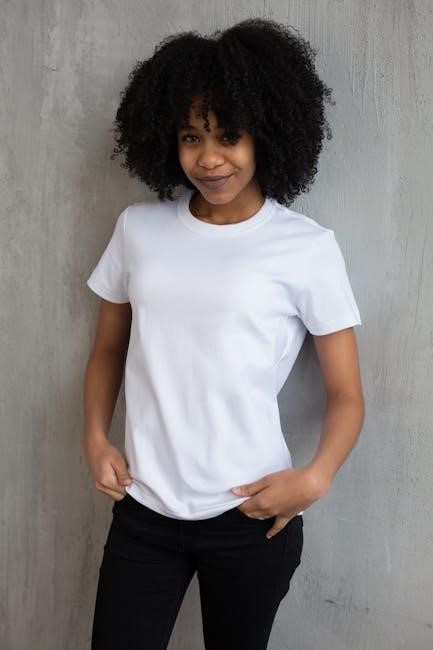Choosing the right t-shirt size for children can be challenging, but with a comprehensive guide, you can ensure comfort and style․ This guide helps parents navigate youth size charts, measurement techniques, and practical tips to find the perfect fit for their kids, ensuring both comfort and confidence․
Understanding Youth T-Shirt Size Charts
Youth t-shirt size charts provide a structured guide to help determine the best fit based on age, weight, height, and body measurements like chest size and shirt length․
2․1․ Age Ranges and Corresponding Sizes
Age ranges are a key factor in determining youth t-shirt sizes, with specific size recommendations for different age groups․ For example, children aged 3-4 years typically correspond to Size 98-104, while 5-6 years align with Size 110-116․ Similarly, 7-8 years match Size 122-128, and 9-11 years fit Size 134-146․ These age ranges are designed to reflect average growth patterns, ensuring a comfortable and appropriate fit․ However, it’s important to consider individual growth spurts and body types, as sizes may vary slightly between brands․ Always refer to the brand’s specific size chart for the most accurate fit․
2․2․ Numeric Size vs․ Chest Measurement
Numeric sizes (e․g․, XS, S, M, L, XL) are commonly used for youth t-shirts, but chest measurements provide greater accuracy․ Numeric sizes can vary between brands and age ranges, while chest measurements offer a direct fit reference․ For example, a Youth XS typically corresponds to a 13-inch chest, Youth S to 14 inches, and so on․ Parents should measure their child’s chest and compare it to the brand’s size chart for the best fit․ This approach ensures comfort and avoids sizing discrepancies, as numeric labels alone may not account for individual growth patterns or body types․
2․3․ Unisex Sizing vs․ Gender-Specific Fits
Youth t-shirts often come in unisex sizes, designed to fit a broad range of body types, or gender-specific fits tailored to boys or girls․ Unisex sizing focuses on age and basic measurements, offering versatility, while gender-specific fits cater to differences in body shape and style preferences; For instance, girls’ t-shirts may have shorter sleeves and a more fitted waist, while boys’ versions might be looser․ Parents should consider their child’s body type and activity level when choosing between the two․ Unisex sizes are practical for everyday wear, but gender-specific fits may offer a better tailored look for some children․

How to Measure Your Child for the Perfect Fit
Accurate measurements are key to finding the perfect fit․ Measure chest circumference, sleeve length, and shirt length using a flexible tape measure․ Compare measurements to a well-fitting shirt for the best results․
3․1․ Measuring Chest Circumference
Measuring chest circumference is essential for determining the correct size․ Wrap a flexible tape measure around the widest part of your child’s chest, typically just under the armpits․ Ensure the tape is level and not too tight or loose․ The measurement should reflect the child’s natural posture․ Record the number and compare it to the size chart․ For accurate results, avoid measuring over bulky clothing․ If the measurement falls between sizes, consider the next size up for comfort․ This step ensures the t-shirt will fit comfortably around the torso, providing the best fit and allowing room for movement․
3․2․ Measuring Shirt Length
To measure shirt length, place the tape measure at the base of the neck, aligning it with the spine․ Extend the tape straight down to the desired hemline, typically just above the hip․ Ensure the child stands upright with arms at their sides for accuracy; The measurement should reflect the shirt’s length, ensuring it’s neither too short nor too long․ Record this measurement and compare it to the size chart․ For a comfortable fit, round up if the measurement falls between sizes․ This ensures the t-shirt provides adequate coverage and comfort, while maintaining a stylish appearance․
3․3․ Measuring Sleeve Length
To measure sleeve length accurately, start at the center back of the neck, just below the base, and extend the tape measure over the shoulder, down to the wrist․ Ensure the arm is slightly bent and relaxed for a natural fit․ Record this measurement and compare it to the size chart․ Sleeve length varies by size and brand, so it’s crucial to reference the specific chart for accurate sizing․ For a comfortable fit, ensure the sleeve reaches the mid-wrist without being too tight or overly loose․ This step ensures the t-shirt provides both comfort and style, with sleeves that complement the overall fit․
Fabric Types and Their Impact on Fit
Fabric types significantly influence a t-shirt’s fit․ Cotton offers breathability and softness, while Polyester Blends provide durability․ Stretch Fabrics enhance flexibility, ensuring comfort for active kids․
4․1․ Cotton vs․ Polyester Blends
Cotton and polyester blends are popular fabric choices for youth t-shirts, each offering unique benefits․ Cotton is known for its softness, breathability, and natural comfort, making it ideal for everyday wear․ However, it may shrink slightly and isn’t as durable as polyester blends․ Polyester blends, on the other hand, offer moisture-wicking properties, resistance to wrinkles, and longer-lasting durability․ They are often preferred for active kids or sports activities․ The choice between the two depends on the child’s lifestyle and preferences, as both fabrics provide excellent comfort and performance in their own ways․
4․2․ Stretch Fabrics for Active Kids
Stretch fabrics are ideal for active children, offering enhanced mobility and comfort during sports or play․ These fabrics, often blends of polyester, spandex, or elastane, provide a four-way stretch, allowing for maximum flexibility․ They are breathable, moisture-wicking, and quick-drying, making them perfect for energetic kids․ Stretch fabrics also retain their shape well, even after repeated washing and wear․ For children involved in sports or outdoor activities, stretch t-shirts are a practical choice, ensuring durability and comfort․ They are also lightweight, reducing irritation during movement․ This makes them a great option for parents seeking high-performance clothing that keeps up with their active lifestyles while maintaining a snug, comfortable fit․

Brand-Specific Youth Sizing
Different brands offer unique sizing standards for youth t-shirts․ Gildan, Nike, Hanes, and Under Armour provide specific charts to ensure accurate fits tailored to their designs and materials․
5․1․ Gildan Youth Sizing Chart
Gildan’s youth sizing chart offers a clear guide for selecting the right t-shirt size․ Sizes range from YXS to YXL, corresponding to numerical sizes 4-18․ The chart includes measurements for chest circumference, shirt length, and width․ For example, YXS fits sizes 5-6 with a chest measurement of 13 inches, while YXL fits sizes 16-18 with a chest measurement of 17 inches․ Additional details like sleeve length and weight ranges are provided to ensure a precise fit․ Gildan’s chart is a reliable tool for parents to find comfortable, well-fitting t-shirts for their children, combining style and practicality․
5․2․ Nike Youth Sizing Guide
Nike’s youth sizing guide provides a detailed chart to help parents select the perfect fit for their children․ The guide includes numerical sizes ranging from 5 to 18, with corresponding chest and length measurements․ For example, size 5-6 measures 13 inches in chest and 18 inches in length, while size 16-18 measures 17 inches in chest and 26 inches in length․ Nike emphasizes the importance of accurate measurements to ensure comfort and mobility․ The chart also offers a link to Nike’s full size chart for additional details․ By following this guide, parents can ensure their kids enjoy a comfortable and stylish fit in Nike t-shirts․
5․3․ Hanes Youth Size Chart
Hanes provides a detailed youth size chart to ensure the perfect fit for kids․ The chart includes numerical sizes ranging from YXS to YXL, with corresponding chest and length measurements․ For example, YXS offers a chest measurement of 13 inches and a length of 18 inches, while YXL provides a chest measurement of 17 inches and a length of 26 inches․ Hanes emphasizes the importance of accurate measurements to ensure comfort and mobility․ Parents can use this chart to select the ideal size for their child, ensuring a comfortable and stylish fit in Hanes youth t-shirts․
5․4․ Under Armour Youth Sizing
Under Armour offers a detailed youth sizing chart to help parents find the perfect fit for their kids․ The chart includes numerical sizes from YXS to YXL, with corresponding chest and length measurements․ For example, YXS fits chests measuring 13 inches with a length of 18 inches, while YXL accommodates chests up to 17 inches with a length of 26 inches․ Under Armour emphasizes performance and comfort, ensuring their youth t-shirts are designed for active kids․ Parents can refer to the chart to select the ideal size, combining style and functionality for their child’s needs, whether for sports or everyday wear․

Seasonal Considerations for T-Shirt Sizes
Seasonal factors can influence your choice of youth t-shirt sizes․ In colder months, layering may require slightly larger sizes for comfort, while warmer weather calls for snug, breathable fits․ Growth spurts during the school year can mean sizing up mid-season․ Consider activities: loose fits for casual wear and fitted styles for sports․ Fabric weight varies by season, with lighter materials in summer and heavier ones in winter․ Always check size charts for seasonal collections, as designs may differ․ Monitoring your child’s growth and activity levels ensures the right fit year-round, balancing comfort and practicality for every occasion․
Common Mistakes to Avoid When Choosing Sizes
When selecting youth t-shirt sizes, avoid common pitfalls to ensure the best fit․ One mistake is not regularly measuring your child, as growth spurts can quickly change size needs․ Another error is assuming all brands use the same sizing standards, which can lead to inconsistent fits․ Ignoring fabric type is also a mistake, as materials like cotton or stretch blends affect how shirts fit․ Additionally, guessing sizes without consulting a size chart can result in poor fit․ Finally, not considering the child’s activity level or personal comfort preferences can lead to dissatisfaction․ Avoid these errors to ensure comfort, style, and practicality in every purchase․

Practical Tips for Parents
Parents can ensure the best fit for their child’s t-shirt by following practical tips․ Always refer to the brand’s specific size chart, as sizing can vary․ Measure your child regularly, as growth spurts can change sizes quickly․ Consider the fabric type—stretch materials are ideal for active kids․ When in doubt, size up to allow for growth․ Encourage your child to try shirts on if possible․ Pay attention to length and sleeve measurements for comfort․ Lastly, involve your child in the selection process to ensure they feel confident and happy with their choice․ These tips help parents make informed, stress-free decisions․
Selecting the right youth t-shirt size is a balance of comfort, style, and practicality․ By understanding size charts, measuring accurately, and considering factors like fabric type and growth spurts, parents can make informed decisions․ Remember, sizing varies across brands, so always check specific charts․ Prioritize comfort and confidence for your child, ensuring they feel great in their clothing․ With these insights, you’re equipped to navigate the world of youth t-shirts effortlessly, ensuring the perfect fit every time․ Happy shopping!
